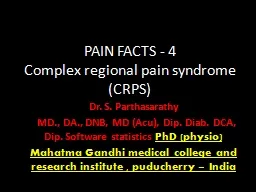

CRPS Dr S Parthasarathy MD DA DNB MD Acu Dip Diab DCA Dip Software statistics PhD physio Mahatma Gandhi medical college and research institute puducherry ID: 911378
Download Presentation The PPT/PDF document "PAIN FACTS - 4 Complex regional pain syn..." is the property of its rightful owner. Permission is granted to download and print the materials on this web site for personal, non-commercial use only, and to display it on your personal computer provided you do not modify the materials and that you retain all copyright notices contained in the materials. By downloading content from our website, you accept the terms of this agreement.
Slide1
PAIN FACTS - 4Complex regional pain syndrome (CRPS)
Dr. S. Parthasarathy
MD., DA., DNB, MD (
Acu
), Dip.
Diab
. DCA, Dip. Software
statistics
PhD
(
physio
)
Mahatma Gandhi medical college and research institute ,
puducherry
– India
Slide2Definition
Complex regional pain syndrome represents an abnormal response to
injury
, usually of an extremity, presenting as prolonged, often intense pain, vasomotor disturbances, delayed functional recovery and trophic changes
Slide3CRPS
Slide4Synonyms Causalgia
,
Sudeck’s
atrophy, post-traumatic dystrophy, shoulder hand syndrome, algodystrophy,algoneurodystrophy, reflex neurovascular dystrophy reflex sympathetic dystrophy
Slide5IASP International Association for the Study of Pain (IASP) introduced a single term
Complex Regional Pain Syndrome
(CRPS, 1994), to accommodate the differing clinical presentationssyndrome may follow as many as 5% of all traumatic injuries.
Slide6Types Type 1 is not associated with a specific nerve injury and
does not follow
an anatomical distribution of a peripheral nerve,
Type II, has similar symptoms and signs to those in Type I, is associated with an identifiable nerve injury
Slide7Three classical stages Acute
:
up to 3 months from the onset. The limb is warm, the skin red, with swelling with
palmar or plantar hyperhydrosis, hyperesthaesia and joint stiffness. No effusion or fixed contractures.
Slide8The other two stages 2)Dystrophic
:
3–6 months after the injury. The limb is cool, cyanotic and
indurated. Hyperaesthesia is present, fixed contractures begin to occur, with ankylotic changes in the small, distal joints of the limb.3) Atrophic: after 6 months. The skin may become hairless and loses its folds. Contractures prevail changes become permanent.
Slide9CRPS is not a non corrupt Govt. official
It can jump to stage 2 or
it can skip stage 2
Slide10Symptomatology Mild
Moderate
Severe
Or
Slide11Symptom type Autonomic : sweating, swelling, warm or cold
Motor : muscle weakness, tremor
Sensory :
pain deep, spontaneous orthostatic, nocturnal Trophic changes : glossy skin, hair nail disturbances osteoporosis
Slide12Special about symptoms Upper Vs lower limb 2 :1 CRPS possible in knee, shoulder, hip etc
Both sides
Rarely all four limbs affected
Peak 50 years age Female more Preceding trauma
Slide13Mechanism of CRPS Every one gets injured
Why some develop CRPS ??
Slide14Prone for CRPS !!1. Genetic2. disuse
3.psychogenic
Slide15Mechanisms increase in the activity of the sympathetic nervous system in response to a noxious stimulus
Pain stimulates sympathetic
But sympathetic stimulates pain ??
Slide16Other mechanisms
Formation of abnormal
synapses
between sympathetic and sensory fibres.A direct nerve injury resulting in an abnormal electrical discharge.disruption of the auto regulation of blood flow An increase in substance P. plastic changes in the peripheral and central nervous system.As a manifestation of a psychosomatic disease.
Slide17Diagnosis Clinical
Sympathetic blockade
Sure it has done the job
Sure that it has not done extra SIP
Slide18Phentolamine infusion test Mixed alpha antagonist
Principle :
norepinephrine
released by nociceptors is blocked Similar results of pain relief as stellate ganglion blockadeSimple , repetition possible
Slide19How to do it ?? Routine monitors, informed consent , RL , baseline pain score ,temperature
Propranolol
1-2 mg IV
Phentolamine 1 mg / kg over 10 minutes VAS, temperature , BP pulse rate
Slide20IVRA with sympatholytics
Guanethidine
Taken up by NA varicosities Depletes NA from sympathetic axonsprevents further release for1-2 daysAvailability ??
Slide21Others Skin blood flow measurements
Ischemia test
Xray
and bone scan
Slide22Treatment of CRPS SMP or not----
Blocks
stellate
, lumbar sympathetic , IVRA – guanethidine , phentolamine
Slide23Drugs
Antidepressants
Anticonvulsants
Alpha2 agonists Alpha blockersOpioids Steroids , NSAIDsTopical
Slide24Treatment and pathophysiology
CRPS
SENSORY
SYMP;
PSYCHO
MOTOR
AUTO INFLM.
NSAIDs, STEROIDS
EPIDURAL,BLOCKS
PHYSIO
ANTIPSYCHIATRI
STELLATE, IVRA
Slide25Article to be published in IJCP 1.Dr. S.Parthasarathy
2.Dr.
M.Ravishankar
Electroacupuncture in Complex regional pain syndrome (CRPS) – a case report from the periphery.
Slide26What happens in acupuncture ?
Slide27Slide28Slide29Why it happens and in what belief
Slide30Slide31Summary Definition Types
Stages
Symptoms
Mechanisms Diagnosis Treatment
Slide32Thank
you all